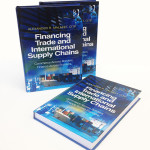 The pursuit of commercial opportunities in international markets involves every challenge and complexity involved in doing business with a local supplier or buyer – magnified and expanded significantly, based on the market(s) in which one chooses to engage.
The pursuit of commercial opportunities in international markets involves every challenge and complexity involved in doing business with a local supplier or buyer – magnified and expanded significantly, based on the market(s) in which one chooses to engage.
Due diligence on a trading partner means:
- The nature of the prevailing legal tradition and the ability (or not!) to enforce redress even if you do “win” the case
- The nuances and complexities of cross-cultural interaction and negotiation
- Selection of local representation
…the list is long, and for many, daunting.
Diligent finance means you get paid
As an exporter (to take one view on the conduct of trade), if you do everything correctly and succeed in closing an attractive deal – or even better, establish a promising relationship – but somehow fail to get paid in the end, after producing and shipping the agreed goods or services, then all that effort and all the skill and effectiveness may be for naught.
This is where a generally misunderstood and underappreciated element of international commerce comes in: trade and supply chain finance.
Before your eyes glaze over in despair and disappointment at the prospect of a discussion of – ugh – finance, think of this as your “SHOW ME THE MONEY” moment.
Trade is a great deal of fun, and it is personally and professionally enriching, but it is, after all, most commonly a commercial undertaking, at the end of which one hopes to be paid handsomely, for having ventured where others dare not.
What do we mean when we say trade finance?
Trade finance – quite literally the financing of international trade – has a long history of operating modestly and quietly in the background, facilitating billions in annual merchandise trade flows without seeking so much as a tip of the proverbial hat in acknowledgment.
It is unassumingly enabling the flow of financing in support of trade, while at the same time, helping to mitigate risks of all kinds, in the most challenging markets on the globe. In this respect, one might say that trade finance is very Canadian in character: effective, low-key and unpretentious.
In our training and advisory activities, and in recently published “Financing Trade and International Supply Chains” (Gower, UK), we argue that trade financing at its core is about some combination of four elements:
- The facilitation of secure and timely payment across borders
- The provision of financing to one or more trading parties
- The effective mitigation of a wide variety of risks
- The enabling of information flow about aspects of the physical and financial flows related to a trade transaction or relationship
Trade finance accounts for trillions of dollars worth of trade transactions
While the use of traditional mechanisms like documentary letters of credit (L/Cs) are in (relative) decline in many markets, the long-established and much-maligned L/C still facilitates roughly 10% of annual merchandise trade flows, which are in the $18 trillion range today.
It does so on the basis of rules and practices that are broadly understood and accepted throughout the world, in no small part due to the work of the International Chamber of Commerce Banking Commission in Paris, and the related jurisprudence that has evolved around such mechanisms.
More recently, and particularly in the post-2009 economic and business environment, many trading partners have opted to shift away from traditional mechanisms, despite their advantages, due to cost and process intensiveness.
Companies of all sizes, in markets around the world, are increasingly conducting business on open account terms – where the exporter produces and ships the agreed goods, and the importer sends payment at an agreed point in the transaction.
Financial institutions and trade finance ‘boutiques’, as well as various technology-based platform providers, have been working to evolve their value proposition in this area.
The brand new world of supply chain finance
Supply Chain Finance (SCF) is so new, in fact, that there is a multi-association effort underway now to devise a common set of nomenclature and terminology around the financing of international supply chains.
This effort falls under the auspices of the ICC Banking Commission that involves numerous specialty industry associations.
Until recently, some providers of traditional trade finance would have contended (perhaps some still do) that there is nothing fundamentally new in SCF. This is, in my view, a short-sighted perspective that ignores one major reality:
The shift to SCF models motivates bankers, financiers and traders to look at the conduct of trade in the context of an ecosystem of trading relationships, and not merely on a bilateral, one buyer, one seller approach.
The need for supplier finance programs
Even as governments tout the importance of SMEs as engines of economic value-creation, there exists an environment (globally) where small and medium-sized enterprises report ongoing, serious challenges in accessing timely and affordable financing in support of their international ambitions. The evolution of trade and supply chain finance is both critically needed and more than welcome
Supplier Finance Programs (also referred to as Buyer-Led Supply Chain Finance, among other terms) are one of the most popular and growing favours of SCF in the market today.
The key in such programs is that a large global buyer engages with their primary banker to provide financing to strategically important members of their (typically emerging market based) SMEs. This is done on the basis of invoices submitted by the qualifying suppliers and approved for payment by the buyer.
In effect, the invoice(s) are discounted, and the supplier receives funds significantly earlier than would otherwise be the case, improving cash flow and working capital.
This financing is extended on the basis of the credit standing of the large buyer (since the bank is ‘lending’ against an invoice that has been approved for settlement).
This tends to make the financing less expensive than what the supplier would be charged on their own merit, and allows the buyer to assure a steady and sustainable supply of key production components from strategic suppliers.
Innovation in SCF solutions
In addition to various SCF techniques taking hold in the market, there is a very visible increase in the application of technology to the provision of trade and supply chain finance.
Trade-related documentation is being increasingly ‘dematerialized’ and dealt with in electronic format. Likewise, settlement and financing models, are shifting from paper-based models to data-driven solutions that take the subjectivity out of payment and financing decisions.
This also accelerates the payment and financing process significantly, and thus helps to inject material amounts of liquidity – read cash – into the global market.
This at a time when industry estimates (Asian Development Bank, 2015) suggest that there is a global gap in trade finance in the range of $1.9 trillion annually, and at a time when government and international institutions are increasingly focused on sustaining the success of SMEs in international markets.
The perennial mission for those of us engaged in this business, to get more Canadian companies and more SMEs in general interested in international markets, continues to be challenging. Post-crisis realities, however, strongly suggest (again!) that market diversification is a critical target for the Canadian economy.
One way to enable companies in pursuit of such opportunities, is to ensure the availability of adequate levels of affordable trade and supply chain finance.
Another would be to provide competent technical advice and the vision necessary to see that there are transformational forces at work in the business of trade and the financing of trade today.
Complacency among traditional providers is a serious risk, when Facebook now has a banking licence from the central bank in Ireland, PayPal is entering the working capital lending business and encouraging cross-border commerce, and Alibaba announces that it will support its trading community with trade financing solutions.
Bottom line? Trade finance is not a luxury or an esoteric branch of financing to be ignored in the hopes it goes away or fades into the background of a transaction. It is a strategically critical enabler of trade activity, and an evolving part of next-generation international commerce.
The advice and support you get in this area can make or break your international trade aspirations and strategy, so challenge conventional thinking and limited vision from your trade financiers, if you run in to it.
What aspects of your international trade financing can you change to improve your business strategies?
What else does Alexander do?
 Learn more about the intricacies of Trade Finance from one of the leading subject market experts on the topic. His critically acclaimed book Financing Trade and International Supply Chains will give you deeper insights into nature of trade finance at its core, and of the versatility of this discipline in enabling trade flows involving businesses of all sizes.
Learn more about the intricacies of Trade Finance from one of the leading subject market experts on the topic. His critically acclaimed book Financing Trade and International Supply Chains will give you deeper insights into nature of trade finance at its core, and of the versatility of this discipline in enabling trade flows involving businesses of all sizes.







disqus comments